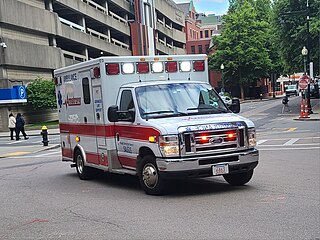
An ambulance is a medically-equipped vehicle used to transport patients to treatment facilities, such as hospitals. Typically, out-of-hospital medical care is provided to the patient during the transport. Ambulances are used to respond to medical emergencies by emergency medical services (EMS), and can rapidly transport paramedics and other first responders, carry equipment for administering emergency care, and transport patients to hospital or other definitive care. Most ambulances use a design based on vans or pickup trucks, though others take the form of motorcycles, buses, hearses, aircraft and boats.

A flashlight or electric torch, usually shortened to torch, is a portable hand-held electric lamp. Formerly, the light source typically was a miniature incandescent light bulb, but these have been displaced by light-emitting diodes (LEDs) since the early 2000s. A typical flashlight consists of the light source mounted in a reflector, a transparent cover to protect the light source and reflector, a battery, and a switch, all enclosed in a case.
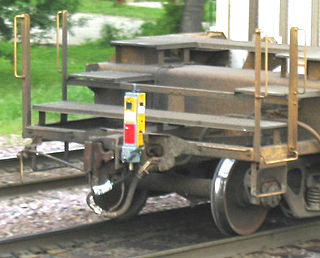
The end of train device (ETD), sometimes referred to as an EOT, flashing rear-end device (FRED) or sense and braking unit (SBU) is an electronic device mounted on the end of freight trains in replacement of a caboose. They are divided into three categories: "dumb" units, which only provide a visible indication of the rear of the train with a flashing red taillight; "average intelligence" units with a brake pipe pressure gauge; and "smart" units, which send back data to the crew in the locomotive via radio-based telemetry. They originated in North America, and are also used elsewhere in the world, where they may include complete End of Train Air System (ETAS) or Sense and Brake Unit (SBU) devices.

A kill switch, also known more formally as an emergency brake, emergency stop (E-stop), emergency off (EMO), or emergency power off (EPO), is a safety mechanism used to shut off machinery in an emergency, when it cannot be shut down in the usual manner. Unlike a normal shut-down switch or shut-down procedure, which shuts down all systems in order and turns off the machine without damage, a kill switch is designed and configured to abort the operation as quickly as possible and to be operated simply and quickly. Kill switches are usually designed to be noticeable, even to an untrained operator or a bystander.

The Ford Expedition is a full-size three-row SUV, manufactured and marketed by Ford over four generations since model year 1997, deriving directly from Ford's concurrent generations of its F-150 pickup truck—and marketed since 2007 in regular and extended lengths, the latter replacing the Ford Excursion. Since 1997, Ford's Lincoln brand has marketed a rebadged variant of the Expedition, as the Lincoln Navigator.
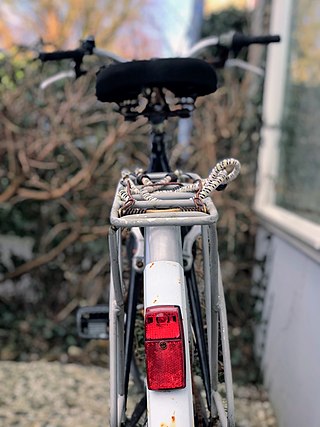
Bicycle lighting is illumination attached to bicycles whose purpose above all is, along with reflectors, to improve the visibility of the bicycle and its rider to other road users under circumstances of poor ambient illumination. A secondary purpose is to illuminate reflective materials such as cat's eyes and traffic signs. A third purpose may be to illuminate the roadway so that the rider can see the way ahead. Serving the latter purposes require much more luminous flux and thus more power.

A police car is an emergency vehicle used by police for transportation during patrols and responses to calls for service. A type of emergency vehicle, police cars are used by police officers to patrol a beat, quickly reach incident scenes, and transport and temporarily detain suspects.

A daytime running lamp is an automotive lighting and bicycle lighting device on the front of a road going motor vehicle or bicycle. It is automatically switched on when the vehicle's handbrake has been pulled down, when the vehicle is in gear, or when the engine is started, emitting white, yellow, or amber light. Their intended use is not to help the driver see the road or their surroundings, but to help other road users identify an active vehicle.

A motor vehicle has lighting and signaling devices mounted to or integrated into its front, rear, sides, and, in some cases, top. Various devices have the dual function of illuminating the road ahead for the driver, and making the vehicle visible to others, with indications to them of turning, slowing or stopping, etc., with lights also indicating the size of some large vehicles.
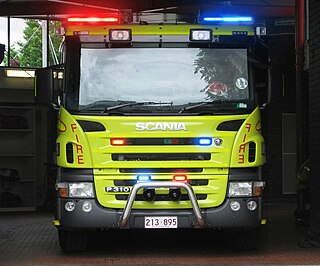
Emergency vehicle lighting, also known as simply emergency lighting or emergency lights, is a type of vehicle lighting used to visually announce a vehicle's presence to other road users. A sub-type of emergency vehicle equipment, emergency vehicle lighting is generally used by emergency vehicles and other authorized vehicles in a variety of colors.

Emergency vehicle equipment is any equipment fitted to, or carried by, an emergency vehicle, other than the equipment that a standard non-emergency vehicle is fitted with.
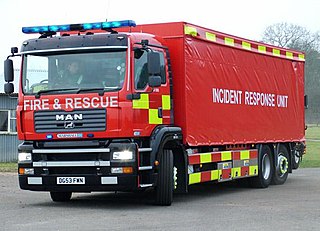
Emergency vehicle equipment is used in the United Kingdom to indicate urgent journeys by an emergency service. This usage is colloquially known as "blues and twos", which refers to the blue lights and the two-tone siren once commonplace. A call-out requiring the use of lights and sirens is often colloquially known as a "blue light run".
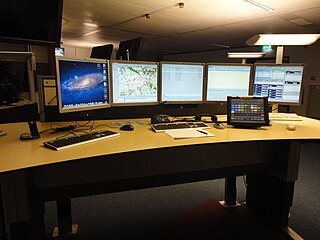
Emergency service response codes are predefined systems used by emergency services to describe the priority and response assigned to calls for service. Response codes vary from country to country, jurisdiction to jurisdiction, and even agency to agency, with different methods used to categorize responses to reported events.

Mobile radio or mobiles refer to wireless communications systems and devices which are based on radio frequencies, and where the path of communications is movable on either end. There are a variety of views about what constitutes mobile equipment. For US licensing purposes, mobiles may include hand-carried,, equipment. An obsolete term is radiophone.
Federal Signal Corporation is an American manufacturer headquartered in Downers Grove, Illinois. Federal Signal manufactures street sweeper vehicles, public address systems, emergency vehicle equipment, and emergency vehicle lighting.

UK Automotive Products Ltd (UKAP) is a supplier of heavy-duty vehicle automotive lighting equipment based in Cannock, Staffordshire. Their product range includes bulb and light-emitting diode lighting - LED lamps, headlamps, lightbars, beacons, direction indicators, HID lighting, interior lamps, number plate lamps, rear and combination lamps, stalk lamps, plus working and driving lamps. As well as this they provide reversing aids, object detection Systems, reflectors (retroreflectors), air horns and modular harnesses.
The Whelen Engineering Company is an American corporation that designs and manufactures audio and visual warning equipment for automotive, aviation, and mass notification industries worldwide. Founded in a Deep River, Connecticut garage in 1952, Whelen has become a provider of warning lights, white illumination lighting, sirens, and controllers. Whelen products are designed, manufactured, and assembled in two facilities in Chester, Connecticut and Charlestown, New Hampshire.

A headlamp, headlight, or head torch (UK) is a light source affixed to the head typically for outdoor activities at night or in dark conditions such as caving, orienteering, hiking, skiing, backpacking, camping, mountaineering or mountain biking. Headlamps may also be used in adventure races. Headlamps are often used by workers in underground mining, search and rescue, surgeons, and by other workers who need hands-free directed lighting.

Courtesy lights are used to request right-of-way primarily by volunteer or on-call firefighters, emergency medical technicians (EMTs), and other first responders to expedite their response in their privately owned vehicles to their firehouse, base, or directly to the scene of an emergency call. Courtesy lights sometimes allow the user to disobey traffic laws such as speed limits, but usually not laws applying to stop signs or stop lights. Courtesy lights should not be confused with emergency warning lights used in conjunction with audible warning systems (sirens) for emergency vehicles such as police cars, fire apparatus, ambulances, etc, nor should they be confused with warning lights as used by tow trucks, snow plows, construction vehicles and school buses to increase awareness especially when moving slowly or stopped in the roadway.

A move over law is a law which requires motorists to move over and change lanes to give safe clearance to law enforcement officers, firefighters, ambulances, utility workers, and in some cases, tow-truck drivers and disabled vehicles. In the past, Canada and the United States have used this term to apply to two different concepts; however, this is beginning to change as Canadian provinces have begun expanding the scope of their move over laws.

















